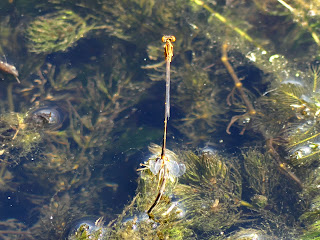Bluets of a Different Color
In contrast to the (frequently vividly) blue bluets I posted Wednesday and Thursday (and earlier), I also saw a pair of Orange Bluets in tandem last spring. You might be thinking: "If it's orange, it should be called something else, like an oranget or something". Let me defend the name a bit:
- The bluets are their closest relatives, and while it's a little unfortunate that the genus was named after a trait this particular species doesn't have as adults, there are more egregious naming problems out there [1].
- As you might have picked up on from the preceding bullet item, immature Orange Bluets actually are a pale blue, though they outgrow it by the time they're ready to breed.
- In some other species of bluet, only the males are blue.
- The Orange Bluet isn't the only bluet where the males are not blue either. In my area the Vesper Bluet (yellow) and the Scarlet Bluet (see if you can guess their color) are the other non-blue bluets.
I suspect this particular picture is showing the female depositing her eggs into the water. In some odonate species, the male stays attached to the female until she lays her eggs. This prevents some other male from swooping in and fathering (or co-fathering) her children.
 |
| June 13, 2023 at Washington Valley Reservoir Photo 300987894, (c) jpviolette, some rights reserved (CC BY-NC) |
 |
| June 13, 2023 at Washington Valley Reservoir Photo 300987869, (c) jpviolette, some rights reserved (CC BY-NC) |
[1] Off the top of my head, the Bald-faced Hornet isn't a hornet at all but is instead a non-yellow yellowjacket. Ring-necked Ducks are named after a feature you can barely see. Mourning Doves are no sadder than other doves/pigeons.



Comments
Post a Comment